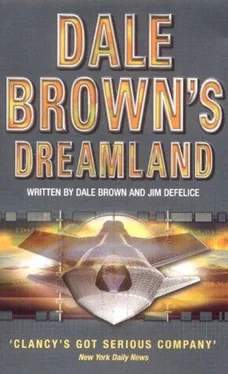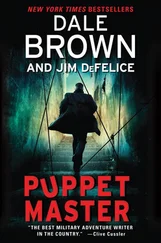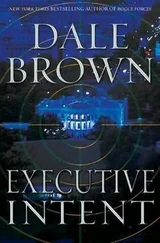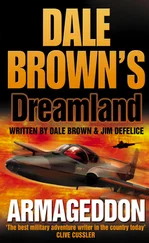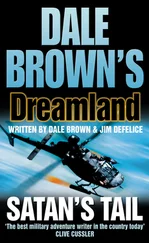“Libya?” asked Johnson.
“Yeah. The Iranians have declared a Muslim coalition against the West,” said Howland. “Libya, Sudan, Iran, now Somalia. Iraq is cheering them on.”
“The usual shitheads,” said Gunny. “They won’t get anywhere.”
“I don’t know,” said Howland. He sat in the seat opposite Johnson. “They’re gloating about Saudi Arabia and Egypt. They think they’re coming in with them. Something about air bases. Probably they didn’t give our planes permission to land.” The pilot shook his head. “There’s a whole lot of shit going down and we’re right in the middle of it.”
“Aw, come on,” said Gunny, trying to cheer him up. “If you’re standing in shit, at least it can’t rain on your head.”
“Unless you slip and fall in it,” said Howland.
“Jeez, Gunny, look at that.” Jackson pointed out the back window. A flatbed truck had pulled up behind them. A huge scrap of black metal was lashed to the rear; Somalians clustered all over the wreckage as well as the roof of the vehicle’s cab.
“My plane,” said Howland. He looked down at Mack. “They must have been waiting for me to open the bay and pickle. I got the warning and started doing evasive maneuvers, but like an idiot I flamed out.”
“You were just unlucky,” said Mack.
“What happened to you?”
“I fucked up,” said Knife.
“Ah, bullshit on that,” said Gunny, his voice almost vicious as he turned from the back window. “Fuckin’ major saved our asses is what he did. That wasn’t no fuckup. And it wasn’t bad luck.”
“Wasn’t good luck,” said Mack.
“No, sir. No fuckin’ sir,” said the sergeant as the bus lurched forward. “But it sure as shit wasn’t a fuck-up.”
Mack fought off the swelling pain in his head to acknowledge the thank-you with a nod.
Northern Ethiopia
23 October, 0300
Breanna pulled back on the control stick despite the warning from the computer that they hadn’t yet reached optimum takeoff speed. She pushed down on the throttle bar with her other hand, as if the extra force might somehow squeeze more oomph out of the four power plants, which were already at max.
She was also mumbling a Hail Mary. Couldn’t hurt.
Despite the computer’s disapproval, Fort Two caught a stiff wind in her chin and lifted off the mesh runway extension, clearing the trees at the far end of the runway with a good two inches to spare. Breanna gave herself a second to exhale, then began banking to swing onto the course north. They would fly at five hundred feet above ground level all the way to the border. At that point, she would take the plane even lower and goose the engines; they would be on their target in precisely five minutes. Chris would unleash the two cruise missiles on the known SAMs.
What happened next depended on the Somalians and the Iranians who were helping them. according to the satellite photos, a ZSU-23 antiaircraft gun sat at the northwestern corner of the complex. It would be nice to eliminate the gun before the MHV-22 Ospreys arrived with their assault teams. On the other hand, the Zeus had a limited line of sight toward that end of the base, so attacking it wasn’t a priority if other defenses had been installed along the southern edge of the old school grounds.
Unfortunately, there was only one sure way to discover if there were additional defenses there – the Megafortress would have to show itself and see if anyone took a potshot at it. It could use its JSOWs on them.
The EB-52’s ECMs would automatically ID all known Soviet-era detection and targeting radars, buzzing bands from Jaybird to Desilu, as Chris liked to joke. At the same time, it could automatically note the source of the radars, supplying the data and signal radios like Raven, for example, nor was it equipped to deal with the next-generation gear found in more sophisticated Western systems. They’d have to punt if they came up against any.
“Vector One and Vector Two are airborne,” said Chris. Pushed to top speed, the tilt-wing rotorcraft transports could approach four hundred knots, more than twice as fast as ‘normal’ helicopters. They were coming in right behind the Megafortress.
Breanna checked her instruments, scanning the glass panels of the cockpit as slowly as she could manage. Time was starting to blur by as quickly as her heat was pounding.
Jeff had told her about the first time he’d been in combat, flying over Iraq. He’d tried to keep calm by counting slowly to himself as he looked at each instrument in his F-15C, counting it off.
That was Mack Smith who’d told her that. Jeff hadn’t flown Eagles in the Gulf.
“Interceptor radar ahead,” said Chris.
Breanna looked at the left MUD, which painted the sky ahead with different colors, indicating the presence of enemy radars. A green blob hung halfway down the screen dripping and fading. The computer was processing signals received by the enemy and plotting them in real time on the screen, color-coding then seriousness of the threat. Green meant that the enemy could not detect them, generally because it was out of range due to the Megafortress’s stealthy configuration or, as in this case, low altitude. Yellow meant that they could potentially be detected but hadn’t been. Red meant that they were being actively targeted.
“We have a MiG-29, two MiG-29’s,” said Chris, working with the computer to ID the threats. At this point they used only passive sensors – active radar would be like using a flashlight in a darkened room. “They’re well out of range. Seem to be tracking north. Thirty miles. Thirty-two. Other side of the border.”
“Keep an eye on them for the Ospreys,” Bree told him.
“Gotcha, Captain.”
Breanna hit her way-point just south of the Somalian border, adjusting her course to track northeastward.
“Lost the MiGs,” said Chris. “Think they were from A-1?”
“A-1’s supposed to be too small for anything bigger than a Piper Cherokee,” said Breanna. The airstrip was located about twenty miles northwest of their target area, right on the coast.
“Maybe from Sudan then. Or Yemen. They have to be working at the very edge of their range.” Chris checked through the paperwork, double-checking their intelligence reports and satellite maps, making sure the MiGs couldn’t have landed anywhere nearby.
“Mark Two in zero-one minutes. Border in zero-one minutes,” the computer told Breanna. It also have her a cue on the HUD that they were nearing the danger zone, spitting back the flight data they had programmed before.
“Stand by to contact Vector flight,” she told Chris. “We’re looking good.”
“Hell of a moon,” he said.
Breanna had not time to admire the scenery. She edged the Megafortress lower toward the ragged steppes and jagged rocks of the African Horn, glancing quickly at the MUD to make sure no enemy radars had suddenly snapped to life. The Megafortress was now skimming over the rocky savanna at a blistering 558 nautical miles an hour. She had to be careful and alert – the EB-52 lacked terrain-following radar. Even with the improved power plants the Megafortress lacked the oomph of, say, an F-111, which could pull up instantly if an obstacle loomed. The computer and sensors helped her stay low along a carefully mapped route.
“Border,” said Breanna. They passed into Somalia, apparently undetected. Their target lay approximately 150 miles dead ahead.
“Preparing to launch cruise missiles,” said Chris, selecting the weapons-control module on his computer display. “Bay.”
The Megafortress was equipped with a rotary launcher in the bomb bay similar to the devices installed in B-52Hs. In a stock B-52, up to eight cruise missiles could be mounted, rotated into position, and then launched. Fort Two’s launcher allowed for a variety of weapons beside the cruise missiles; in this case, two Scorpions AMRAAM-plus air-to-air missiles and four JSOW weapons, which had imaging infrared target seekers. The AGM-86c cruise missiles had to be preprogrammed, a relatively laborious task for someone like Chris who wasn’t used to doing it. But once they were launched they did all the work.
Читать дальше
